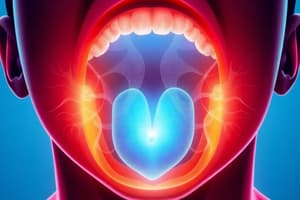Podcast
Questions and Answers
What is the approximate daily production of saliva in a healthy adult?
What is the approximate daily production of saliva in a healthy adult?
- 3.0 - 3.5 liters
- 0.5 - 1.0 liters
- 2.0 - 2.5 liters
- 1.0 - 1.5 liters (correct)
Which salivary gland contributes the largest percentage of saliva volume?
Which salivary gland contributes the largest percentage of saliva volume?
- Sublingual
- Submandibular (correct)
- Parotid
- Minor salivary glands
Which of the following is NOT a function of saliva?
Which of the following is NOT a function of saliva?
- Regulation of blood pressure (correct)
- Protection against bacterial infection
- Lubrication of the oral cavity
- Digestion of carbohydrates
What is the difference between serous and mucous saliva?
What is the difference between serous and mucous saliva?
What is the term used to describe a condition of dry mouth?
What is the term used to describe a condition of dry mouth?
Flashcards
Saliva
Saliva
A colorless, slightly sticky solution made by salivary glands, consisting of organic and inorganic components.
Components of Saliva
Components of Saliva
Includes organic substances like enzymes and mucins, and inorganic ions like sodium and potassium; each has specific roles in oral health.
Salivation
Salivation
The process of producing saliva, which is stimulated by the central nervous system in response to food or thought of food.
Major Salivary Glands
Major Salivary Glands
Signup and view all the flashcards
Factors Affecting Salivary Flow
Factors Affecting Salivary Flow
Signup and view all the flashcards
Study Notes
Saliva Composition
- Saliva is mostly water (99%).
- The remaining 1% is composed of organic and inorganic substances.
- Saliva composition can vary significantly, depending on what's eaten and the method used to collect it for analysis.
Saliva Production
- Adults produce between one and one and a half litres of saliva daily.
- Saliva is produced by salivary glands (major and minor).
- The submandibular glands account for 60-65% of total saliva volume.
- Parotid glands contribute 25%.
- Sublingual glands produce 5-10%.
- Minor salivary glands produce less than 10%.
Functions of Saliva
- Protective: Glycoproteins create a lubricating and waterproof layer for oral tissues, protecting against abrasion and aiding speech. Saliva also maintains healthy mucosa and forms a barrier to protect teeth from acid attacks. Serous saliva cleanses the mouth.
- Buffering: Ions in saliva maintain the pH balance, neutralising acids and alkalis, preventing bacterial colonization. Bicarbonate ions are especially important during higher salivary flow.
- Digestion: Salivary amylase begins the digestion of complex carbohydrates.
- Taste: Saliva dissolves substances, enabling taste perception. Difficulty perceiving tastes can result from reduced saliva flow (xerostomia).
- Antimicrobial: Saliva's proteins destroy or prevent harmful bacterial colonization. Immunoglobulins (e.g., IgA) clump bacteria for removal.
Saliva Components (Organic)
- Proteins: Various proteins, including mucins and enzymes, contribute to saliva's viscosity and antibacterial properties.
- Immunoglobulins (Ig's): IgA, IgG, and IgM help remove bacteria by clumping, a process termed agglutination, and work alongside serous saliva.
- Enzymes: Important enzymes include lysozyme (breaks down bacterial cell walls), lactoferrin (inhibits bacterial growth), lactoperoxidase (inhibits bacterial growth), amylase (digests starch), ribonuclease (breaks down RNA), and phosphatase (involved in calculus formation and caries remineralisation).
- Mucin: Glycoproteins that contribute viscosity. Mucoproteins contain more than 4% carbohydrates; glycoproteins less than 4%.
- Waste Products: Urea neutralises acids; uric acid and ammonia are by-products of cellular metabolism.
Saliva Components (Inorganic)
- lons: Mineral salts in solution, primarily responsible for buffering and maintaining pH. Calcium phosphate ions are critical in caries incidence and calculus formation.
- Other Ions: Sodium, potassium, magnesium, chloride, fluoride (important in remineralisation, antibacterial action and protecting against decay), bicarbonate (a buffer), and hydrogen are present.
- Gas Components: Oxygen and nitrogen are present and carbon dioxide levels may be linked to calculus formation.
Saliva and Caries
- Saliva plays a crucial role in controlling acid conditions in the mouth.
- Imbalances in saliva pH, mineral content, and quantity affect caries development.
- Lower saliva pH values can promote the release of minerals from the tooth enamel, resulting in demineralization.
- Conversely, increased saliva pH can lead to remineralization.
Saliva-related Medical Conditions
- Hypersalivation: Excessive saliva production due to various factors.
- Xerostomia: Reduced saliva production leading to dry mouth/oral discomfort and potentially issues with oral health.
Saliva and Cross-infection
- Saliva can transmit various viruses, including COVID-19, hepatitis B, hepatitis C, herpes simplex, Epstein-Barr, and tuberculosis.
Mechanism of Salivation
- Salivation is a reflex, stimulated by sensory inputs such as sight, smell, and taste.
- Both sympathetic and parasympathetic nervous systems regulate salivary gland activity. The sympathetic system reduces flow (e.g. when stressed), whilst parasympathetic increases flow (e.g. when eating or seeing something appetising).
Salivary Flow Factors
- Factors Increasing Flow: chewing (mastication), irritants, gingival conditions, hunger, smell/sight of food, teething in infants.
- Factors Reducing Flow: drugs, diabetes, alcohol, fear, radiotherapy, surgery.
Glands
- Parotid: Located near the ear, receives sympathetic stimulation from the middle meningeal artery through the otic ganglion and auriculotemporal nerve, part of the mandibular division of the trigeminal nerve.
- Submandibular: Receives autonomic stimulation. Sympathetic from facial artery,
- Sublingual: Receives parasympathetic stimulation from the facial nerve via chorda tympani.
Taste Supply
- Anterior 2/3 of tongue: Taste buds send signals via the lingual nerve to the submandibular ganglion. These signals travel along the chorda tympani – a branch of the facial nerve – to the brainstem.
- Posterior 1/3 of tongue: Taste buds transmit information via the glossopharyngeal nerve to a nucleus in the brainstem.
Additional Resources
- Several journal articles and YouTube videos offer further insights into saliva topics.
Studying That Suits You
Use AI to generate personalized quizzes and flashcards to suit your learning preferences.



